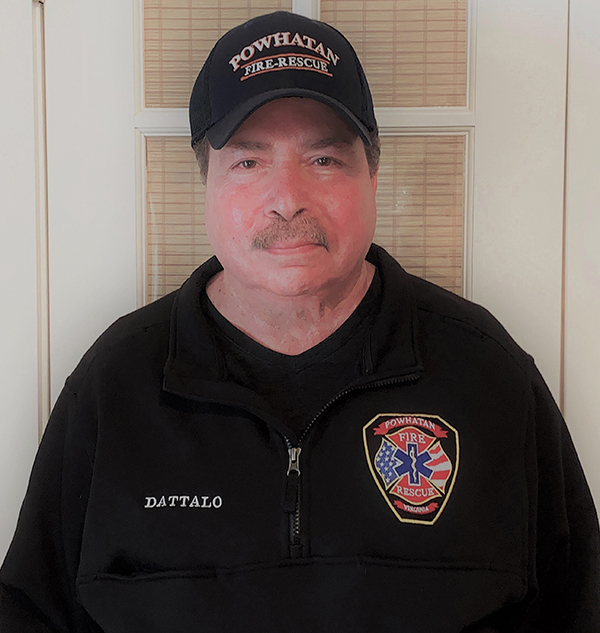Ph.D. to EMT: A social work fixture for 40 years, Dattalo finds his niche as volunteer
Professor Pat Dattalo, Ph.D., has been teaching since the early 1980s, and even in retirement from the VCU School of Social Work, he’s got another group with which he can listen and learn.
Dattalo, who joined the school full time in 1986, made his retirement official in October. Having started about four years ago as a volunteer with Powhatan County Fire and Rescue, he will continue in his role as an ambulance driver and a nationally certified emergency medical technician (EMT) and trainer.

“I really loved my time with the (VCU) students, and it’s one of the reasons why I’m helping with EMS training,” he says. “I just helped with a four-hour class and told my wife, Marie Guay, that it was great. I wondered if I’d still enjoy being in the middle of a crowd of students, and I still do.”
A two-time VCU alum, Dattalo (M.S.W.’80/SW; Ph.D.’93/H&S) started teaching as an adjunct instructor. He was a last-minute replacement for his former social work professor, Charles Bernard “Bernie” Scotch, Ph.D., for a summer course. Dattalo quickly became a fixture, teaching three courses each year before joining the school full time as the director of continuing education.
He continued to teach – macro courses, policy courses, human behavior. He taught research courses across the B.S.W., M.S.W. and Ph.D. programs. “That was a point of pride,” he says.
Dattalo published three books on advanced statistical methods between 2008-2013, including one, Determining sample size: Balancing power, precision, and practicality, that was translated into Chinese.
Frank Baskind, Ph.D., has known Dattalo since 1992, when Baskind joined the school as dean.
“Pat was dedicated to teaching and working with students to understand the value of understanding research methods and statistics for the social work practitioner,” says Baskind, dean emeritus and professor. “When I returned to the school and classroom instruction (in 2013, after serving as university ombudsman), Pat was the member of the school faculty who was most helpful assisting me to adjust to the dynamics of instructing students. One of the things he said to me remains valuable today: ‘have fun.’ Pat has a keen wit and has inspired me to become more comfortable and my true self returning to full-time instruction. I will miss his presence on campus.”
With a number of personnel changes around the school, Baskind wound up in Dattalo’s old office in the Academic Learning Commons following his colleague’s retirement. “Frank moving in is comforting to me,” Dattalo says. “I’d rather he had it than anyone else.”
For some of them, it’s the first time they’ve seen someone who had just died, so we talk about that. … I have a voice that I try not to overuse, and it’s very much a social work voice.
Pat Dattalo, Ph.D.
As he transitions from his academic life, Dattalo sees plenty of commonality between the roles of social worker and emergency medical technician: helping underserved populations by addressing physical trauma and mental health needs of patients.
“Powhatan is mostly rural, and in need of EMS services; transport time to the nearest hospital can take up to an hour, depending on which end of the county you’re on,” Dattalo says. “There are a lot of underserved people in the western portion of the county. It’s tough.
“There is a strong relationship between social work and emergency medical services, since both require a basic understanding of the human condition and the ability to communicate clearly and kindly at the level of the patient. It’s a real mix of people problems, and that’s basically the breadth of social work.”
He ticks off a sample of calls: a man standing in his underwear and socks after losing his house in a fire, child abuse and domestic violence cases, active shooters, a fatal motorcycle accident.
“We debrief as a team after every traumatic call,” Dattalo says. “For some of them, it’s the first time they’ve seen someone who had just died, so we talk about that. … I have a voice that I try not to overuse, and it’s very much a social work voice.”
Dattalo credits his wife for finding an announcement in the local paper five or six years ago about the fire and rescue department seeking volunteers. “I had been telling her that I needed to start to plan for retiring from VCU. I didn’t want life to end there, I wanted to find something of substance that I could transition to that would keep me sane. It did not occur to me that it would be a natural transition, but as soon as I got in there, I knew it was going to be a good thing – if they’ll have me, I’ll stay.
“I know some people who are a little younger than me but have been in the fire department for a decade, and they say, ‘we never had anyone like you volunteer here.’ I realized it was a compliment. I didn’t know how I’d be accepted as someone from an academic background.”
His workload is typically a 12-hour shift on Monday and training every month or two. “It’s enough hours for me … I’m not 21, and 21-year-olds get tired, too,” says Dattalo, 71. “It’s hard, but people thank you all the time and are grateful that you’re there.”
Those younger colleagues, he says, are “not such a different crowd than VCU students, and that’s really comforting to me. I do miss the VCU students, and the good news is that a lot of the beginning EMS students are in their 20s. When you spend 12 to 24 hours with people once or twice a week, you get to know them pretty quickly. I give them my time, but I get 100 times more back. I have learned much more about EMS from them than they can ever learn from me.”
Categories Community, Faculty and staff